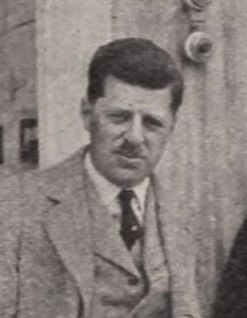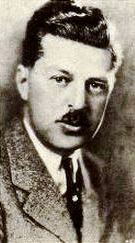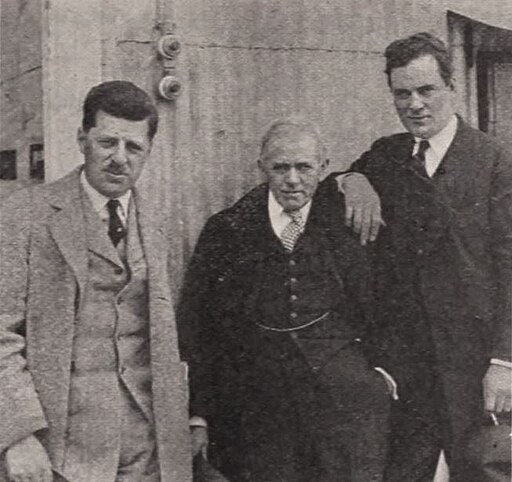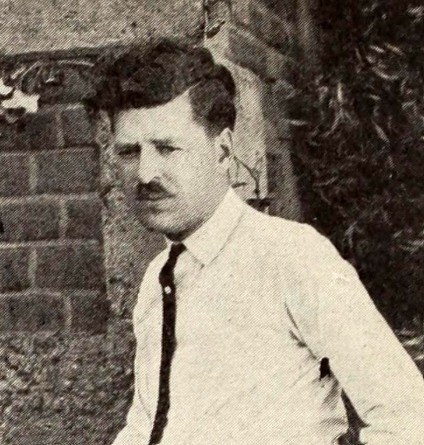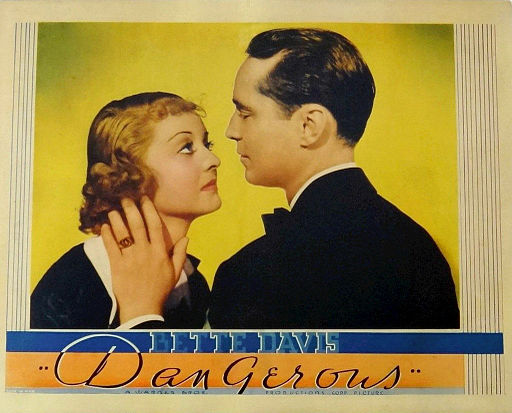Alfred E. Green
back| Full Name | Alfred Edward Green |
| Born | July 11, 1889 |
| Birthplace | Perris, California, USA |
| Died | September 4, 1960 |
| Buried | Forest Lawn Memorial Park (Hollywood Hills), Los Angeles, California, USA |
| Married to | Vivian Reed (married in 1916) |
| Children | Douglas Green - Hilton A. Green - Marshall Green |
| Notable films | Baby Face (1933) - Dangerous (1935) - The Jolson Story (1946) |
Alfred E. Green
Pioneering Craftsman of Classic Cinema
Alfred E. Green was a prominent American movie director whose career spanned from the silent film era through the 1950s. He began his directing career in 1912, working initially for the Selig Polyscope Company and later for Universal and other studios.
Green's directorial style was characterized by his ability to adapt to the changing technologies and tastes of the film industry. He made a successful transition from silent films to talkies, unlike many of his contemporaries. Green was known for his work with top Hollywood actors, including directing Bette Davis in "Dangerous" which earned her an Oscar.
Related
Alfred E. Green
Biography and Career Overview
Alfred Edward Green was born on July 11, 1889, in Perris, California. Growing up in the early 20th century, Green was fascinated by the burgeoning art of cinema, which was still in its infancy. His early fascination with storytelling and performance would eventually shape his future contributions to the film industry.
Green began his career in the film industry as an actor in 1912 but quickly transitioned to directing, a role in which he found his true calling. He directed his first film in the same year for the Selig Polyscope Company. As the silent film era flourished, Green honed his craft and became known for his ability to draw out nuanced performances from his actors, which was essential in the silent film medium.
Transition to Sound Films
With the advent of sound films, many directors found it difficult to adapt, but Green transitioned smoothly. His early sound films showcased his adeptness at integrating dialogue and sound with visual storytelling. He directed Bette Davis in "Dangerous" (1935), which earned her an Academy Award for Best Actress. His handling of the film was noted for its dramatic depth and strong character development, setting a standard for future performances.
Major Works and Contributions
Throughout the 1930s and 1940s, Green's reputation grew. He directed several significant films during this period, including "Baby Face" (1933), starring Barbara Stanwyck, which became notorious for its bold portrayal of a woman using her sexuality to gain power. Another notable film was "The Jolson Story" (1946), a biographical musical that achieved both critical acclaim and box office success. The film was praised for its innovative use of sound and music, reflecting Green's skill at merging technology with artistic expression.
Personal Life
In 1916, Alfred E. Green married Vivian Reed, a former actress. Their partnership was not just bound by personal ties but also professional, as Reed appeared in some of his earlier films. The couple had three sons: Douglas Green, Hilton A. Green, and Marshall Green, all of whom pursued careers in the film industry, thereby continuing their father's legacy in various capacities.
Later Career and Death
Continuing to direct into the 1950s, Green's later career included a mix of genre films, showcasing his versatility. Despite the changing landscape of Hollywood, he remained a respected figure for his foundational influence in the early days of American cinema.
Alfred E. Green passed away on September 4, 1960, in Hollywood, California. His burial was at Forest Lawn Memorial Park (Hollywood Hills), where he rests among many other stars of the Golden Age of Hollywood.
Alfred E. Green's career spanned nearly five decades, during which he directed over 100 films. His work helped shape early Hollywood cinema, especially in the transition from silent to sound films. His films not only entertained millions but also helped to pioneer new techniques in the art of film-making. His legacy is carried on through the timeless quality of his films and the ongoing work of his descendants in the industry.
Trailer from The Dark Horse, directed by Alfred E. Green:
Notable Movies Directed by Alfred E. Green:
1910s
"The Temptation of Adam" (1916): A short film depicting the biblical story of Adam and Eve, exploring themes of temptation and morality in a silent film format.
1920s
"Sally" (1925): A silent comedy film about a dishwasher who rises to fame as a dancer, capturing the essence of the Jazz Age and its optimistic spirit.
1930s
- "Baby Face" (1933): Starring Barbara Stanwyck, this film follows a young woman who uses her relationships with men to climb the social ladder, pushing the boundaries of the Pre-Code Hollywood era.
- "Dangerous" (1935): A drama featuring Bette Davis in her Academy Award-winning role as a troubled actress whose self-destructive habits threaten both her career and personal life.
1940s
- "The Jolson Story" (1946): A biographical musical that chronicles the life of entertainer Al Jolson, celebrated for its musical sequences and regarded as one of the best examples of biopics from the era.
- "Copacabana" (1947): A musical comedy starring Groucho Marx and Carmen Miranda, involving a duo trying to break into show business with multiple identities.
1950s
"The Eddie Cantor Story" (1953): A musical biographical film about the life of Eddie Cantor, a famous comedian and performer, focusing on his rise to fame and personal challenges.
1960s
"Invasion of the Saucer Men" (1967): Although released after his death, this film was a B-movie cult classic featuring a teenage couple encountering aliens, blending sci-fi with humor.
Alfred E. Green’s Directing Style:
Alfred E. Green's directorial style is notable for its adaptability and understated competence, which allowed him to successfully navigate the evolving landscape of Hollywood from the silent era through the rise of sound films and into the golden age of cinema. His approach to filmmaking was characterized by several distinctive traits:
Adaptability Across Eras
Green began his directing career in the silent film era, a time when visual storytelling was paramount. His early films often focused on expressive acting and meticulous staging to convey emotion and narrative. As cinema transitioned to include sound, Green smoothly adapted his techniques to incorporate dialogue and audio elements without sacrificing the visual style that marked his earlier works. This adaptability was key to his sustained success, as he continued to make relevant and popular films throughout the changing dynamics of Hollywood.
Actor's Director
Green was known as an "actor's director," skilled at eliciting strong performances from his cast. He directed Bette Davis in her Oscar-winning role in "Dangerous" (1935), which showcased his ability to work closely with actors to draw out nuanced performances. His direction helped actors deliver their roles in a way that was both profound and relatable, often elevating the overall impact of the film.
Narrative Focus
Throughout his career, Green showed a strong preference for narrative-driven films. Whether he was working on dramas, biopics, or comedies, his films consistently demonstrated a clear and engaging storyline. Films like "Disraeli" (1929) and "The Jolson Story" (1946) highlight his ability to handle complex narratives, presenting historical and biographical tales with clarity and emotional depth.
Technical Competence
Green’s films were technically solid, often employing straightforward cinematography and editing techniques that served the story rather than overshadowing it. His technical style did not seek to innovate radically but rather to competently deliver the story to the audience. This approach made his films accessible and enjoyable, focusing on storytelling rather than technical spectacle.
Genre Versatility
Green was not tied to any specific genre, having directed everything from musicals and comedies to dramas and action films. This versatility is a testament to his fundamental understanding of film as a medium and his ability to apply his directorial skills across different types of stories. "Copacabana" (1947) and "Invasion of the Saucer Men" (1957) exemplify his range, showcasing his ability to direct both musical comedy and science fiction with equal proficiency.
Legacy and Influence
While not as frequently discussed as some of his contemporaries, Green’s work has had a lasting impact on the industry, particularly through his successful navigation of the transition from silent films to talkies and his consistent ability to direct films that met the commercial and artistic demands of their times.
In summary, Alfred E. Green's directorial style was characterized by his adaptability, actor-focused approach, narrative clarity, technical competence, and genre versatility. These qualities helped him maintain a prolific and successful career in Hollywood over several decades.
Awards and Recognition:
Academy Awards
- "Disraeli" (1929): Although Alfred E. Green did not receive a direct nomination for his work, the film earned George Arliss an Academy Award for Best Actor, a testament to Green's effective direction.
- "Dangerous" (1935): Bette Davis won the Academy Award for Best Actress for her role in this film directed by Green. The award highlighted Green's adeptness at directing actors in complex, emotional roles, bringing out performances that garnered critical acclaim and industry accolades.
Other Recognitions
- "The Jolson Story" (1946): This film was another example of Green’s effective direction leading to significant award recognition, though indirectly in terms of his personal nominations. It received six Academy Award nominations and won two (Best Musical Score and Best Sound Recording). The film was particularly praised for its sound, which was integral to its success as a musical biopic.
Legacy and Honorary Recognitions
While Alfred E. Green did not receive a plethora of personal awards, his films' success at major awards highlighted his role as a skilled director. His legacy is built on his pivotal role in transitioning from silent to sound films and his ability to craft films that met both commercial success and critical acclaim.
Overview of Notable Movies Directed by Alfred E. Green:
1910s
- The Temptation of Adam (1916)
- The Flaming Omen (1917)
- Her Country's Call (1917)
- Vengeance and the Woman (1917)
1920s
- The Man Who Won (1923)
- In Hollywood with Potash and Perlmutter (1924)
- Sally (1925)
- The Girl from Montmartre (1926)
- Irene (1926)
- Ella Cinders (1926)
- The Auctioneer (1927)
- Ladies Must Dress (1927)
1930s
- Disraeli (1929)
- The Green Goddess (1930)
- Old English (1930)
- The Rich Are Always with Us (1932)
- Silver Dollar (1932)
- Parachute Jumper (1933)
- Baby Face (1933)
- The Dark Horse (1932)
- Dangerous (1935)
- The Goose and the Gander (1935)
- Colleen (1936)
- More Than a Secretary (1936)
- The Duke of West Point (1938)
- King of the Turf (1939)
1940s
- Flowing Gold (1940)
- South of Suez (1940)
- East of the River (1940)
- Meet the Stars #6: Stars at Play (1941, Short)
- Bad Men of Missouri (1941)
- A Dispatch from Reuter's (1940)
- Sierra Sue (1941)
- Adventure in Washington (1941)
- Thoroughbreds (1944)
- The Jolson Story (1946)
- Copacabana (1947)
- The Fabulous Texan (1947)
- Four Faces West (1948)
- Cover Up (1949)
1950s
- Sierra Passage (1950)
- The Eddie Cantor Story (1953)
- Paris Model (1953)
- Top Banana (1954)
- Invasion of the Saucer Men (1957)
1960s
- The Girl on the Late, Late Show (1969, TV Movie)

